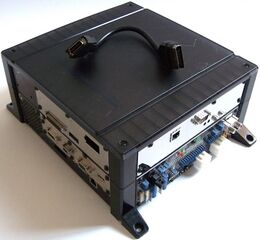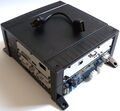Difference between revisions of "Sega Chihiro"
From Sega Retro
| Line 9: | Line 9: | ||
| processor=Pentium III | | processor=Pentium III | ||
| releases={{releasesArcade | | releases={{releasesArcade | ||
| − | | | + | | system_date_jp=2002 |
| + | | system_date_us=2003 | ||
| + | | system_date_uk=2003 | ||
}} | }} | ||
}} | }} | ||
| − | The ''' | + | The '''Chihiro''' is an arcade system produced by [[Sega]] and [[Microsoft]] based on the [[Xbox]] home video game console{{ref|https://web.archive.org/web/20071118203705/http://sega.jp/corp/release/2002/0918/}}. It was the second such partnership, with Sega also siding with [[Namco]] and [[Nintendo]] with the [[Nintendo GameCube]]-powered [[Triforce]] system. |
| + | |||
| + | ''[[The House of the Dead III]]'' was the first game to launch for the platform in late 2002. | ||
| + | |||
| + | ==Hardware== | ||
| + | The Chihiro is based upon the [[Xbox]], using the same Pentium III CPU and NVIDIA graphics card. Unlike the Xbox however it uses [[GD-ROM]] media instead of DVDs (with some exceptions; see below), has more RAM and an earlier revision chipset which is used in the Xbox debugging unit (MCPX2). Because of the similar hardware, it is in theory relatively easy to port Chihiro games to the Xbox and PC. The GD-ROM board can be configured to store up to 1GB of data from the GD-ROM like with the [[Triforce]]. | ||
There was also a Satellite Terminal version of the Chihiro. | There was also a Satellite Terminal version of the Chihiro. | ||
| − | ==Technical specifications== | + | ===Technical specifications=== |
* CPU: Intel Pentium III 733MHz (133MHz FSB) | * CPU: Intel Pentium III 733MHz (133MHz FSB) | ||
* Graphics: [[NVIDIA]] XChip 200MHz (based on the NVIDIA GeForce 3) with NV2A architecture | * Graphics: [[NVIDIA]] XChip 200MHz (based on the NVIDIA GeForce 3) with NV2A architecture | ||
Revision as of 08:00, 12 December 2020

| |||||||||||||||||

| |||||||||||||||||
| Sega Chihiro | |||||||||||||||||
|---|---|---|---|---|---|---|---|---|---|---|---|---|---|---|---|---|---|
| Manufacturer: Sega | |||||||||||||||||
| Variants: Chihiro Satellite Terminal | |||||||||||||||||
|
The Chihiro is an arcade system produced by Sega and Microsoft based on the Xbox home video game console[1]. It was the second such partnership, with Sega also siding with Namco and Nintendo with the Nintendo GameCube-powered Triforce system.
The House of the Dead III was the first game to launch for the platform in late 2002.
Contents
Hardware
The Chihiro is based upon the Xbox, using the same Pentium III CPU and NVIDIA graphics card. Unlike the Xbox however it uses GD-ROM media instead of DVDs (with some exceptions; see below), has more RAM and an earlier revision chipset which is used in the Xbox debugging unit (MCPX2). Because of the similar hardware, it is in theory relatively easy to port Chihiro games to the Xbox and PC. The GD-ROM board can be configured to store up to 1GB of data from the GD-ROM like with the Triforce.
There was also a Satellite Terminal version of the Chihiro.
Technical specifications
- CPU: Intel Pentium III 733MHz (133MHz FSB)
- Graphics: NVIDIA XChip 200MHz (based on the NVIDIA GeForce 3) with NV2A architecture
- System Chipset: NVIDIA MCPX2
- RAM: 128MB DDR SDRAM at 200MHz
- Polygons: 125M polys/sec
List of games
Chihiro Games
- Crazy Taxi: High Roller (2003)
- Ghost Squad (2004)
- Mobile Suit Gundam 0079 (2006)
- Ollie King (2004)
- OutRun 2 (2003)
- OutRun 2 SP (2004)
- The House of the Dead III (2003)
- Virtua Cop 3 (2003)
- Wangan Midnight: Maxi Boost / Wangan Midnight : Maximum Tune (2005)
- Wangan Midnight: Maxi Boost 2 / Wangan Midnight : Maximum Tune 2 (2005)
- Wangan Midnight: Maxi Boost 2 Ver.B / Wangan Midnight : Maximum Tune 2 Ver.B (2005)
Chihiro Satellite Terminal Games
- MJ2 (2003)
- MJ3 (2005)
- MJ3 Evo (2007)
- Mobile Suit Gundam 0079 Card Builder (2005)
- Mobile Suit Gundam 0083 Card Builder (2007)
- Quest of D (2004) (uses CD-ROM instead of GD-ROM)
- Quest of D: Gofu no Keisyousya (2005)
- Quest of D: Oukoku no Syugosya (2006)
- Quest of D: The Battle Kingdom (2007)
- Sangokushi Taisen (2005) (uses DVD-ROM instead of GD-ROM)
- Sangokushi Taisen 2 (2006) (uses DVD-ROM instead of GD-ROM)
- Sangokushi Taisen 3 (2008) (uses DVD-ROM instead of GD-ROM)
- Sega Golf Club Network Pro Tour (2004)
- Sega Golf Club Version 2006: Next Tours (2006)
Photo gallery
Promotional material
References
- ↑ http://sega.jp/corp/release/2002/0918/ (Wayback Machine: 2007-11-18 20:37)
| Sega arcade boards |
|---|
| Originating in arcades |
|
77
78
79
80
81
82
83
84
85
86
87
88
89
90
91
92
93
94
95
96
97
98
99
|
| Console-based hardware |
|
84
85
86
87
88
89
90
91
92
93
94
95
96
97
98
99
00
01
02
03
04
05
06
07
08
09
10
11
12
13
14
|
| PC-based hardware |
|
05
06
07
08
09
10
11
12
13
14
15
16
17
18
19
20
21
22
23
|


